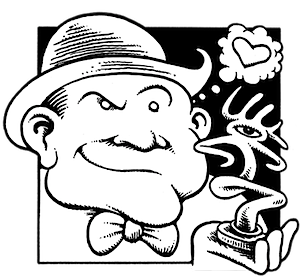|
WILL
EISNER (1917-2005) Complete 7-page Spirit Story
June 18, 1950 (but much is 1948).
"WILLUM AND THE BARON" (also called "Willum the
Waif).
Background: In 1948,
at the height of The syndicated weekly Spirit, Will
Eisner separately started his own comic book company.
Two were published: Baseball Comics and Kewpies
(neither drawn by him). The third, which was by him,
was titled John Law, but because sales on the first
two were poor, Eisner quickly ended his comic book
publishing experiment. The unpublished John Law comic
pages sat on his shelf for two years until he faced
deadline pressure with The Spirit and he decided to
recycle the stories. The most famous is the 2-part "Sand
Saref" in which he slightly altered Detective
John Law (similar but with an eye patch) to
become The Spirit, and changed Chief Bunyan
into Commissioner Dolan. Many fans considered the Sand
Saref series to be among the best-ever Spirit stories
(revealing details of Denny Colt's early years
and early romance with Sand) but fans till fairly
recently never knew these "1950" stories began in 1948
as John Law stories. (The Before & After can be
seen in the John Law: Dead Man Walking book from IDW
Publishing.)
In other stories from that 1948
effort John Law had a sidekick named Nubbin the
Shoeshine Boy. Again facing a deadline problem,
Eisner recycled a good portion of that story in
mid-1950 to become "Willum and the Baron." The name Willum,
a nickname for William, is probably an in-joke
reference to Will himself (William Eisner). It should
be easy to see in the photos which parts of the art
were drawn in 1948 because they are cut- and-pasted,
with the remaining art drawn in 1950. 1948 art is: the
boy and dog on the opening page; most off the art on
pages 2, 3, and 4; and the Baron's face in the 2nd
panel of page 7. Pages 5 and 6 have no paste- ups. To
some collectors, paste-ups are not desirable. To
comics archaeologists, like myself, stories like this,
with a fascinating history, are special. This is the
latest Spirit story in the chronology to incorporate
Will's 1948 art, the period many consider his
strongest year, when he took the time to carefully
pencil and and distinctively shade ("feather") each
panel. The 1950 panels are still very good, but are
drawn somewhat faster, without the full craftsmanship
displayed in 1948.
Condition: Numerous
paste-ups as noted above because of story conversion.
Significant White-out on some pages (usually to help
disguise the paste-up borders). White tape at the
bottom and top of pages.
Size: 15 x 22 inches
(38 x 56 centimeters) on heavy Bristol board. Comes in
vintage 39 x 57 cm storage envelope with Eisner's
handwriting.
Provenance: Warranted
to be from the Will Eisner estate, which this agency
exclusively represents.
|
































